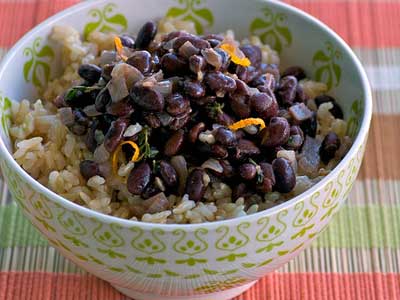 There are just some things that instantly take me back to my childhood. Sopaipillas do that to me every time. Made by my grandmother, the tender warm pillows of fried dough were sprinkled with cinnamon sugar and drizzled with honey and always disappeared within minutes. She would encourage us to eat them immediately while they were still warm, but it was always said with a wink in her eye – she knew we couldn’t keep our hands off them until there was an empty plate of grease-laden cinnamon-scented crumbs.
There are just some things that instantly take me back to my childhood. Sopaipillas do that to me every time. Made by my grandmother, the tender warm pillows of fried dough were sprinkled with cinnamon sugar and drizzled with honey and always disappeared within minutes. She would encourage us to eat them immediately while they were still warm, but it was always said with a wink in her eye – she knew we couldn’t keep our hands off them until there was an empty plate of grease-laden cinnamon-scented crumbs.
My grandmother was the best cook I have ever known (next to my mom, of course!). She was in the kitchen every day and her way with food was astonishing, no matter what she prepared. But unlike her rice and beans, sopaipillas were for special events (as were her bunuelos, too). It was usually Christmas or New Year’s Eve when she would make dough and fry it in her cast iron skillet, and I always wondered why we had to wait so long. To a child eleven months might as well be an eternity.
Traveling the world you’re bound to find various versions of hot-oil-meets-dough desserts, whether it be beignets, youtiao, malasadas, loukoumades or gulab jamun. Unfortunately I adore every single one of them. But sopaipillas top my list, and not just because of their familial significance but also because they are among the most basic of all fried dough desserts. A very simple dough puffs up in the hot oil in a matter of minutes, and when drizzled with honey it’s pure nirvana.
 I have just returned from an incredible week sailing the Aegean on the luxurious Seabourn Quest. (http://www.seabourn.com) It’s truly a wonderful way to travel and I highly recommend the experience.
I have just returned from an incredible week sailing the Aegean on the luxurious Seabourn Quest. (http://www.seabourn.com) It’s truly a wonderful way to travel and I highly recommend the experience.
 My love affair with food began in the dim dark ages of the glorious 1990’s, when neon was king and it was cool to rock a mullet while listening to Marky Mark and his Funky Bunch. Born in San Diego and being brought up by a Hawaiian family from beautiful Kaneohe, greatly impacted my palate, and brought me to the culinary forefront well before my time.
My love affair with food began in the dim dark ages of the glorious 1990’s, when neon was king and it was cool to rock a mullet while listening to Marky Mark and his Funky Bunch. Born in San Diego and being brought up by a Hawaiian family from beautiful Kaneohe, greatly impacted my palate, and brought me to the culinary forefront well before my time. There are just some things that instantly take me back to my childhood. Sopaipillas do that to me every time. Made by my grandmother, the tender warm pillows of fried dough were sprinkled with cinnamon sugar and drizzled with honey and always disappeared within minutes. She would encourage us to eat them immediately while they were still warm, but it was always said with a wink in her eye – she knew we couldn’t keep our hands off them until there was an empty plate of grease-laden cinnamon-scented crumbs.
There are just some things that instantly take me back to my childhood. Sopaipillas do that to me every time. Made by my grandmother, the tender warm pillows of fried dough were sprinkled with cinnamon sugar and drizzled with honey and always disappeared within minutes. She would encourage us to eat them immediately while they were still warm, but it was always said with a wink in her eye – she knew we couldn’t keep our hands off them until there was an empty plate of grease-laden cinnamon-scented crumbs.
 The other day I received a flyer advertising a romantic Caribbean get-away. It showed a scantily clad, deliriously happy couple lounging on the beach, cocktails in hand. I ripped it in half and tossed in the recycle bin. When you're married to someone whose Twitter handle is
The other day I received a flyer advertising a romantic Caribbean get-away. It showed a scantily clad, deliriously happy couple lounging on the beach, cocktails in hand. I ripped it in half and tossed in the recycle bin. When you're married to someone whose Twitter handle is 